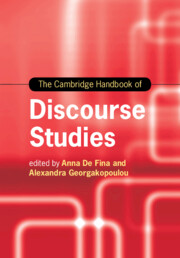Book contents
- The Cambridge Handbook of Discourse Studies
- Cambridge Handbooks in Language and Linguistics
- The Cambridge Handbook of Discourse Studies
- Copyright page
- Contents
- Figures
- Tables
- Contributors
- Preface
- Part I (Con)Textualizing Discourses
- Part II Perspectives and Modes of Analysis
- 6 Sequence Organization: Understanding What Drives Talk
- 7 Doing Micro-Analysis of Discourse: The Case of Ageing and Wellbeing
- 8 Corpus-Assisted Discourse Studies
- 9 Cognitive Linguistic and Experimental Methods in Critical Discourse Studies
- 10 Metaphor, Metonymy and Framing in Discourse
- 11 Poststructuralist Discourse Studies: From Structure to Practice
- Part III Discourse Materialities and Embodiment
- Part IV (Trans)Locations and Intersections
- Part V Ethics, Inequality and Inclusion
- Part VI Discourses, Publics and Mediatization
- Index
- References
10 - Metaphor, Metonymy and Framing in Discourse
from Part II - Perspectives and Modes of Analysis
Published online by Cambridge University Press: 28 September 2020
- The Cambridge Handbook of Discourse Studies
- Cambridge Handbooks in Language and Linguistics
- The Cambridge Handbook of Discourse Studies
- Copyright page
- Contents
- Figures
- Tables
- Contributors
- Preface
- Part I (Con)Textualizing Discourses
- Part II Perspectives and Modes of Analysis
- 6 Sequence Organization: Understanding What Drives Talk
- 7 Doing Micro-Analysis of Discourse: The Case of Ageing and Wellbeing
- 8 Corpus-Assisted Discourse Studies
- 9 Cognitive Linguistic and Experimental Methods in Critical Discourse Studies
- 10 Metaphor, Metonymy and Framing in Discourse
- 11 Poststructuralist Discourse Studies: From Structure to Practice
- Part III Discourse Materialities and Embodiment
- Part IV (Trans)Locations and Intersections
- Part V Ethics, Inequality and Inclusion
- Part VI Discourses, Publics and Mediatization
- Index
- References
Summary
Metaphor involves the perception of similarities or correspondences between unlike entities and processes, so that one can experience, think and communicate about one thing in terms of another – lives as journeys, minds as machines, emotions as external forces, and so on. A consistent thread in the history of the study of metaphor concerns the potential of different metaphor choices to reflect and facilitate different ways of viewing topics or phenomena – a function of metaphor that is itself metaphorically captured by the notion of “framing.” The related phenomenon of metonymy, although less well studied in these terms, also facilitates framing in discourse. In this chapter, we review research on the framing power of metaphor and metonymy, with a particular focus on studies that are relevant to or directly concerned with the use of metaphor in discourse, broadly conceived. We begin with an overview of rhetorical approaches to metaphor as a tool for persuasion and of cognitive approaches to metaphor as a tool for thinking, including both theoretical and empirical studies. We review a variety of studies that have investigated the framing function of metaphor, and, to a lesser extent, metonymy, in authentic language use from a range of sources (e.g. politics, science and education) and using different qualitative and/or quantitative methods. Focusing on metaphor, where the evidence is most robust, we critically examine the relationship between, broadly speaking, cognitive and discourse-based approaches to metaphor. We go on to provide a concrete example of the framing function of metaphor in healthcare discourse, and show how cognitive and discourse perspectives can be usefully combined into a multilevel analytical framework that can, among other things, be used to make recommendations for professional practice and training.
Keywords
- Type
- Chapter
- Information
- The Cambridge Handbook of Discourse Studies , pp. 213 - 234Publisher: Cambridge University PressPrint publication year: 2020
References
Further Reading
This shows how metaphor and metonymy are used to promote particular interpretations of a conflict event in Russia. It is argued that, in this way, the structure of the event itself is modified.
This outlines cognitive, discourse-analytic and practice-based perspectives to metaphor and framing, arguing that each is best suited for particular types of research goals. It sets out a blueprint for how different approaches to metaphor and framing can be integrated into a coherent model.
This is a review of the state of knowledge on how and under what conditions metaphors have been found to shape thinking. Theoretical and practical implications, as well as key challenges and opportunities for future research, are highlighted throughout.
References
- 3
- Cited by

